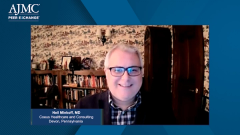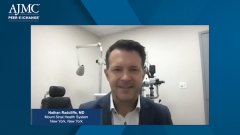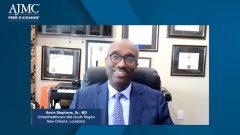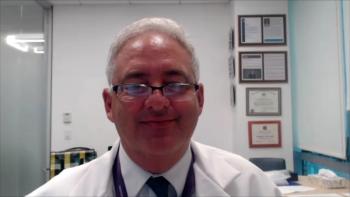
An Overview of Treatment Options for Glaucoma
A broad review of therapeutic classes approved for the management of glaucoma and how they may be sequenced.
Episodes in this series

Transcript:
Neil Minkoff, MD: And just to help make sure that we’re all at least on a level playing field discussing these, could you talk about some of the different classes of medications that you would use in glaucoma and give some examples of why you pick those classes over other classes for a patient?
Nathan Radcliffe, MD: Yes. The first-line therapy is widely considered the prostaglandin analogue, essentially 0 systemic adverse effects and mostly local adverse effects, which eye doctors are great at handling local adverse effects around the eye. They have great efficacy and, good tolerability with hyperaemia being the main adverse effect of those medications. Then we move on to some of the traditional therapies. Those include the aqueous suppressant class of medications, beta blockers, timolol maleate being the most widely used. We also have carbonic anhydrase inhibitors, topical in this case, as well as alpha agonists. Mostly brimonidine is the only molecule in that class.
Of those 3 that I just mentioned, we’ve got fixed combinations which are the staple of modern pharmacotherapy. Fixed combinations are the fastest growing class of medications, and the reason for that is that patients, most of whom have low health literacy in this regard and poor dexterity because they’re aging, and have trouble juggling more than 1 or 2 bottles a day. If you can put them together, it’s a real quality of life benefit. It’s also an area where most ophthalmologists disagree with the FDA [Food and Drug Administration]. FDA is hesitant to approve fixed combinations, and we want them all in 1 bottle. It’s a struggle for us.
Recently, we’ve had a new class of medications, our first class in a very long time called the rho-kinase inhibitors. And, again, it was just 1 company that makes those and just 1 molecule, netarsudil [Rhopressa]. That is available in a fixed combination with a prostaglandin analogue, which is unique because that’s the only fixed combination we have with a prostaglandin analogue. It’s interesting, there’s only 1 representative of the prostaglandin analogue class that’s generic and it’s latanoprost [Xalatan]. It’s the most widely used molecule for glaucoma. There are other generics, but they must be single-source generics. They’re prohibitively expensive, and if it’s a generic prostaglandin analogue, even though we have 5 or 6 branded alternatives, we really only have 1 generic available.
Neil Minkoff, MD: This is probably a naїve question, but why is the need for combination? I get the need for combinations in 1 vial because that’s for the patient and it can be difficult to maybe apply the drops or what have you. But what percent of patients with glaucoma end up needing combination or multiple drug therapy?
Nathan Radcliffe, MD: It’s about 50%. That’s maybe a little surprising, but we’ve learned that you want probably about 35% pressure reduction, and the prostaglandin analogue class gets you 30% to 35%. If that’s the mean, you can imagine half the people don’t achieve that mean and will need a supplemental agent to get the desired pressure reduction. Also, as we treat earlier and as we are better and better [at] recognizing disease, we’re more aggressive. We have good technology to detect progression, that’s wonderful. The downside is that you have a person on 1 drop, and they progress, well you’ve got to add a drop. We realize we have to be aggressive. Almost every glaucoma patient gets worse during their lifetime even if they’re treated and even if they’re treated well. It’s just part of the disease. We have to be aggressive and that’s where you end up using more than 1 therapy.
Neil Minkoff, MD: I guess my follow-up question then would be I’m very interested in hearing both your opinion and Dr Pickering’s opinion on this is 1 of the things that we like in managed care are guidelines and pathways. You start with drug A or class A, and then you move to class B, and then you add class C and so on, like we do with say diabetes medications or cardiac medications or something like that, CHF [congestive heart failure] medications. Is there a progression that you normally follow in these patients? I guess is part A and part B are you, as glaucoma specialists, seeing the patient too late for that and you have to max everything out?
Terri-Diann Pickering, MD: The answer is yes and no. In theory, we would start with the most effective drops first, which are the prostaglandin analogues, and that is what I try to do. However, they have a particular adverse effect. If your iris is hazel, which means it’s a mixture of brown and green or brown and blue, 40% of those people will have a permanent iris color change to brown. So, on that basis alone, most of my hazel-eyed patients or even if you have light brown eyes that can become dark brown, they will not accept using a prostaglandin. We can have a decision tree, but in the face of looking at a particular patient, literally looking at their eyes we can’t use the most effective medication.
Then you go to the second tier, which might be carbonic anhydrase inhibitor, and those are sulfa-based, and many people are allergic to sulfa. Then you go on to another second tier drop which is brimonidine, and that is a generic and that is helpful. But for my older patients, particularly for some reasons females, they can get fatigue on that medication. Then you’re left with the beta blockers is very nice, it’s been around for decades, it’s generic, you can’t use it for my patients with asthma, CHF or COPD [chronic obstructive pulmonary disease]. The problem with treating glaucoma is that we’ve got lots of drops, but looking at any individual patient, we can eliminate 1, 2, 3, or even 4 entire classes of medications, which leaves us with these much more expensive sort of newer drops that no matter how we try to appeal aren’t approved. That becomes challenging.
Transcript edited for clarity.
Newsletter
Stay ahead of policy, cost, and value—subscribe to AJMC for expert insights at the intersection of clinical care and health economics.



















































